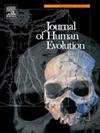新的u系列日期在佩特拉罗纳头盖骨上,这是欧洲人类进化的关键化石
IF 3.1
1区 地球科学
Q1 ANTHROPOLOGY
引用次数: 0
摘要
为希腊佩特拉罗纳洞穴中发现的几乎完整的头盖骨确定年代非常重要,因为这块化石在欧洲人类进化中占有关键地位。这个话题自60多年前被发现以来一直在争论,突出了在史前样本中应用物理测年方法的困难。先前对不同类型样本的研究结果得出的年龄范围在170至700年前之间,这就排除了对人类化石年龄的任何共识。另一方面,尽管各种研究人员作出了种种努力,但头盖骨的原始地层位置仍然是一个谜。在这里,我们展示了对直接生长在头盖骨上的方解石进行的新的u系列日期测定,这是唯一能够提供化石年龄关键信息的样本。结果表明,Petralona头盖骨的最小年龄为286±9 ka。在洞穴的三个主要地点取样了其他洞穴和钙质涂层;其中,样本来自“陵墓”,据说头盖骨是在那里被粘在墙上的。数据显示,覆盖头盖骨的方解石与陵墓墙壁的方解石不是同时代的,这与之前的想法不同。本文讨论了不同的可能性,这取决于头盖骨是否附着在墙上。从形态学的角度来看,佩特拉洛纳人族是一个比智人和尼安德特人更独特、更原始的群体的一部分,新的时代估计进一步支持了这一群体与尼安德特人谱系在欧洲中更新世晚期共存的观点。本文章由计算机程序翻译,如有差异,请以英文原文为准。
New U-series dates on the Petralona cranium, a key fossil in European human evolution
Assigning an age to the nearly complete cranium found in the Petralona Cave in Greece is of outstanding importance because this fossil has a key position in European human evolution. This topic has been debated since its discovery more than 60 years ago, highlighting the difficulties in applying physical dating methods to prehistoric samples. Previous results obtained on various types of samples yielded a large age range between about 170 and 700 ka, precluding any consensus on the age of the human fossil. On the other hand, the original stratigraphic position of the cranium also remains enigmatic, in spite of all the efforts provided by various researchers. Here, we present new U-series dates performed on the calcite that grew directly on the cranium, which is the only sample able to provide crucial information on the age of the fossil. The results yield a finite age suggesting that the Petralona cranium has a minimum age of 286 ± 9 ka. Other speleothems and calcitic coatings were sampled in three main locations in the cave; among them, samples came from the ‘Mausoleum’ where the cranium was supposedly found cemented to a wall. The data show that the calcite covering the cranium is not contemporaneous with that of the Mausoleum wall, despite what was previously thought. The different possibilities, depending on whether or not the cranium was attached to the wall, are discussed in the paper. From a morphological point of view, the Petralona hominin forms part of a distinct and more primitive group than Homo sapiens and Neanderthals, and the new age estimate provides further support for the coexistence of this population alongside the evolving Neanderthal lineage in the later Middle Pleistocene of Europe.
求助全文
通过发布文献求助,成功后即可免费获取论文全文。
去求助
来源期刊

Journal of Human Evolution
生物-进化生物学
CiteScore
6.30
自引率
15.60%
发文量
104
审稿时长
3 months
期刊介绍:
The Journal of Human Evolution concentrates on publishing the highest quality papers covering all aspects of human evolution. The central focus is aimed jointly at paleoanthropological work, covering human and primate fossils, and at comparative studies of living species, including both morphological and molecular evidence. These include descriptions of new discoveries, interpretative analyses of new and previously described material, and assessments of the phylogeny and paleobiology of primate species. Submissions should address issues and questions of broad interest in paleoanthropology.
 求助内容:
求助内容: 应助结果提醒方式:
应助结果提醒方式:


